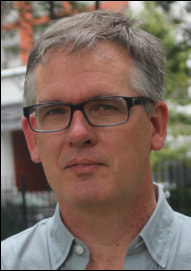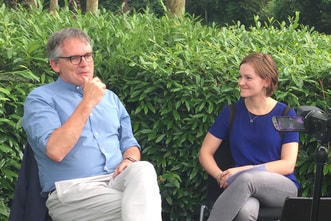|
BY EKATERINA DOBRYAKOVA --- See David Poeppel's OHBM2016 Keynote Lecture here: https://www.pathlms.com/ohbm/courses/3189/video_presentations/33864 --- Today, we're talking to David Poeppel, finding out about the differences between animal and human communication systems, his role in developing models of language processing, and in peeling away the 'speechyness' of speech. Dr. Poeppel is a Professor of Psychology at the New York University and Director of the Department of Neuroscience at the Max Planck Institute in Frankfurt, Germany. As one of the OHBM 2016 keynote speakers, Dr. Poeppel discussed how research in the neurobiology of language has developed over the last 20 years. We took the opportunity to find out more about his research on speech perception and psychophysics.  Dr. David Poeppel Dr. David Poeppel Ekaterina Dobryakova: To start, I wondered why you decided to study language and, specifically, speech perception? David Poeppel: Well, it's easy to want to study language because it's what makes us “us”. It’s the most convenient and compelling feature that we have. If we didn't have that, we couldn’t have this conversation. There are endless vitriolic debates about how similarly animals communicate with each other, so it's deeply fascinating. How can we understand anything? How can we talk? If you ever take a class in linguistics, it’s like opening the curtains – you suddenly understand something you didn't think could be studied by sciences, because if you take a language class, let's say, in middle school or high school, they drown you with minutia in a very boring way and they try to take all the joy out. We've all taken second language French or Spanish in high school--oh my God, you know, what a nightmare--but if you suddenly think of it as a problem for sciences, it becomes a completely different kind of thing. ED: You mentioned animal communication. How would you say our human communication through language is similar to non-language communication between animals? DP: That is a good, hard, deep question for which we have no good answer. Animals are at the periphery, using the apparatus we have, the input systems and the output systems. We can learn a lot from studying animal communication systems. But there are certain attributes of human language that are just quite different, and for which we have no compelling animal model. So, some of the things we study are birdsongs or gestural communication. And those are wonderful important additions to our knowledge. But there are certain attributes of being a speaker of the language as a human that are unusual and that includes the peculiarly structured and complicated vocabulary. ED: What is one of the most important projects that you are focusing on in your lab and how is it relevant to society? DP: My laboratory focuses on basic science. That is, basic questions about the organization of perceptual systems, the auditory system and how we process language. We don't build products, diagnoses, therapeutic interventions. But of course the long term goal is that the insights we bring will help in all of these issues: for group communication, diagnosis, stroke, disease or rehabilitation, developmental disorders, you name it. So some of the work we've done has some very interesting and practical implications for developmental speech disorders. Max Planck has a good one-liner: ‘The application has to be preceded by basic insight’. I think this is very right: to really try to understand the system and its parts, and how they interact before you build the thing. You know, you want me to test the stuff before I give you a pill. Now, I think, we're beginning to enter the age of maturity, where we can celebrate the amazing tools we have and the techniques and analytic approaches we have, and we can start to feel a bit critical about our own research.  ED: What would you say is your most surprising finding? DP: The most surprising finding is that we ever find anything! That's why we're at this OHBM 2016 meeting. One of the remarkable things of the last 20 or 30 years is the astonishing technical development, the devices that we all use. This is quite a remarkable achievement. I remember when I was a graduate student and I read the first papers on imaging, some of which were actually on language, I was both simultaneously excited and appalled. And it really stimulated me and made me very passionate about the stuff. But notice that until 20 years ago we were not able to do any of the things we're now addressing. It was inconceivable. Let's say there was the age of fascination, the age of growth. Now, I think, we're beginning to enter the age of maturity, where we can celebrate the amazing tools we have and the techniques and analytic approaches we have, and we can start to feel a bit critical about our own research. So here are two things that I've worked on a lot in my lab, both of which, I naively hope, have some value: One is really questions about the structural organization of the brain. So with one of my close colleagues, Greg Hickok from Irvine, for many years we've developed a functional and anatomical model, pretty widely known as the dual stream model of language processing, which admittedly we stole straight from the visual system. We know a lot about the visual system and its anatomical physiological foundations, and some of those ideas struck us as potentially useful for the language system. The second thing is the work that I've been focusing on for a number of years on neurophysiology and there, primarily, I’ve been using magnetoencephalography, MEG. It’s the technique I’ve begun to obsess about the last few years, primarily because perceptual processing and language processing is super fast. ED: What is your biggest dream in research? DP: Maybe your dreams get more modest as you cross into the precarious years of middle age. Of the many dreams I have for my labs, one that I'm particularly obsessing about right now is: What does it mean to store your words. Those are sort of at the intersection of everything. There are a hundred thousand things stored in your memory in a way that they can be listened to, spoken, read, signed. That means that the encoding of that is extremely complicated and subtle. ED: What do you think is the coolest finding in the neuroimaging of language? DP: I'd have to say all of my own [laughs]. I'll tell you one that I care about right now and I think is cool: there continues to be a long debate about specialization in the brain. Let's take speech perception. Speech perception is the transformation of acoustic information (so something hits your ear) into some code that's relatively abstract and that interfaces with linguists. Now, for 50 years there's been a very vigorous debate if that is a special mechanism or is it a generic mechanism. So, is speech perception merely a species of hearing, or is it actually something that deals with particular functions? And so, last year, in a very elaborate series of fMRI experiments in my lab, we tackled this question one more time, trying to really nail down the extent to which there is specialization, in part, building on our dual stream model. We predicted that some very specific chunks of cortex, particularly, aspects of the superior temporal gyrus and superior temporal sulcus are not just generic auditory analyzers but are specialized for speech. That doesn't mean that entire area is specialized, but that means that there are populations of cells there that really deal with that kind of signal. So we went to great effort to make stimuli which could selectively peel away the speech-yness of signal and see can you find an area in your head that has the right sensitivity for speech and the right specificity. That was the kind of an experiment that was not just one experiment but 10. But at the end, it is pretty satisfying, because you feel like you really nailed it. I think, we can say pretty conclusively, that there is a high degree of specialization in a particular area of the brain. That's kind of cool because it shows that you can take a pretty innovative technique like functional MRI and answer a classical question. ED: Many thanks! Prof Poeppel’s keynote speech on ‘New Directions in the Neurobiology of Language’ will soon be available to view on the OHBM OnDemand portal. Keep checking for this and other great talks from OHBM 2016. Thanks to Sarabeth Fox for video recording.
1 Comment
Felix
9/7/2016 01:27:31 am
Thanks for the interview and transcription! The collaborator from Irvine is Greg Hickok, not Greg Scott, though.
Reply
Your comment will be posted after it is approved.
Leave a Reply. |
BLOG HOME
Archives
January 2024
|
 RSS Feed
RSS Feed